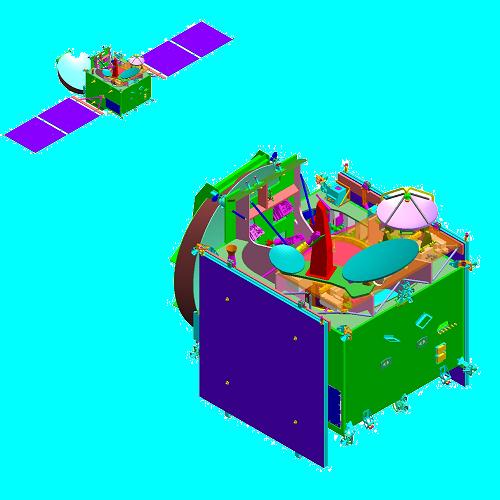Moshe Kerat, CEO of Israel Aerospace Industries, welcomed the contract that was signed, and noted that Israel Aerospace Industries will implement 3 innovative and advanced technologies in the development of the communications satellite, and will continue to be an important and central factor in the Israeli and global space market

The satellite is loaded - above - general view. Below: Enlargement of the main part where all the systems required to operate the satellite will be installed. Illustration: The Aerospace Industry
After negotiations that lasted about eight months, the Space Communications Company announced that it is purchasing the Amos 3 satellite from the Aerospace Industry for 170 million dollars.
Amos 3, which will replace the aging Amos 1, is scheduled to be delivered to the company on the last day of 2007. The longevity of satellites is essential due to the high cost of their construction. Amos 1 is expected to function for about 12 years (although in the planning there is talk of only ten years) and so is Amos 3. The space company expects revenues of at least 40 million dollars a year, at full capacity, according to the current uses of Amos 2, which is owned by Space. Amos 3 has a potential advantage in the field of high frequencies, which is absent from Amos 2, which allow the transfer of video data and Internet-based data. However, it is still difficult to estimate the volume of income from this sector, which was much talked about back in the days of the bubble.
Moshe Kerat, CEO of IAI, welcomed the contract that was signed, and noted that IAI will implement the development of the communication satellite loaded with 3 innovative and advanced technologies, and will continue to be an important and central factor in the Israeli and global space market.
Amos 3 will replace the Amos 1 satellite, which has been operating since 1996, without malfunctions and is supposed to end its life in 2008.
The satellite structure will be based on an Amos 2 structure with improved performance of the communications platform that will include 15 high-power transponders (channels) in two frequency ranges and the addition of 3 antennas, 2 of which have adjustable transmission from the ground. Together with Amos 2, which has been operating for a year and a half, the number of responders in space will increase significantly.
In addition to the expanded service areas existing in Amos 2, Amos 3 will provide services using the mobile beam antennas to any point in the Middle East, Europe, Africa and parts of the American continent: USA, Canada and South America.
The satellite communication tower will be provided by Alcatel Alanya, the world's leading company in satellite communication towers. The aerospace industry states that this contract is a pillar of the aerospace industry's space activity, which has greatly accelerated in recent years.
The four stakeholders in the space company own about 81% of the company's shares, in equal parts: Eurocom Holdings; M.M. Satellites and Communications - which purchased Mr.'s share; and the General Company for Satellite Services. The fourth interested party is the Aerospace Industry, which will receive 20% of the revenue on Amos 3 if it extends its life beyond its 12th year, and on the condition that it goes into the air during the days of Amos 1.
In addition, Halal will pay the aerospace industry an amount of 2.4 million dollars for annual maintenance of the satellite, the same amount as that paid for Amos 2. Following the deal, Halal enters into heavy financial obligations and will be forced to show good performance, or high occupancy of its satellites, in order to meet them.
The CEO of the company, David Polak: "Growing business means taking risks, but we are sure that we will meet all our commitments. The deal with the government allows us to see a price of 110 million dollars of the total cost of the satellite, different from the quoted price. We hope that our occupancy of the existing satellites, and the possibility of offering new services, will prove themselves."
The entry of Amos 3 into full operation is expected to allow Space to make a significant leap forward in terms of revenues, since unlike Amos 3, in Amos 1, which is intended for replacement, Space's role is the marketing of the space segments, where the revenues are negligible compared to the leasing of the space segments - the main activity of satellite owners. The telecommunications companies lease the right to use the satellite frequencies in order to provide television, internet and personal communication services. These frequencies are an expensive commodity, since they allow almost all types of data to be transferred at high speed, but on the other hand, their number is limited and their allocation is competitive.
Chaval's biggest customer is YES. New services that are expected to arrive in Israel in the near future, such as HDTV services, will also increase Chaval's revenues from YES.
Space plans to finance the bulk of the transaction in two main ways: the first is an offering to institutional bodies and the public in the amount of approximately 70 million dollars, which will go into high gear after the holidays. The second is leasing part of the space segments to the government for about 60 million dollars. Halal has not yet signed the agreement with the government and it is expected to be delayed a little, due to the holidays and vacations in the government offices. In addition, Chaval raised $27 million in bonds in March of this year, which were used for the down payment on the deal.

